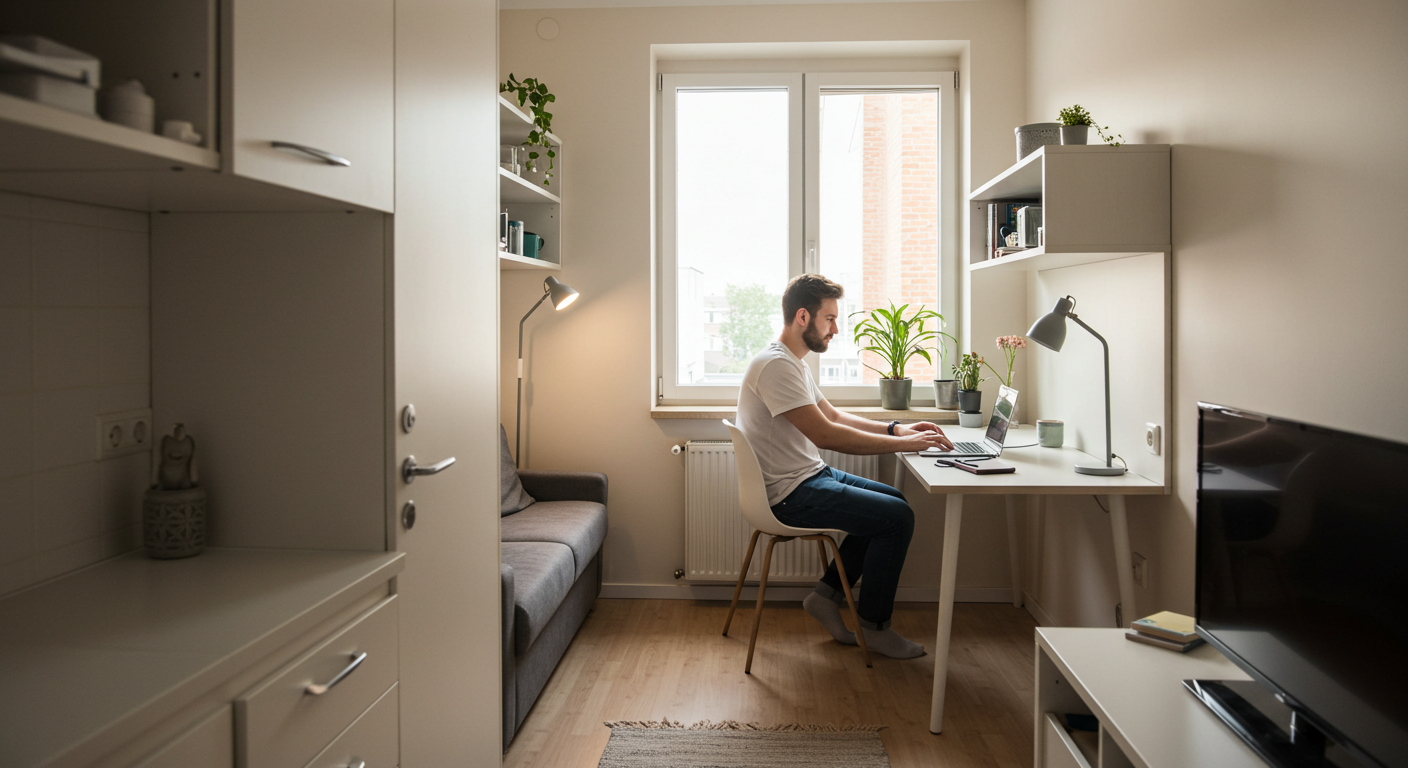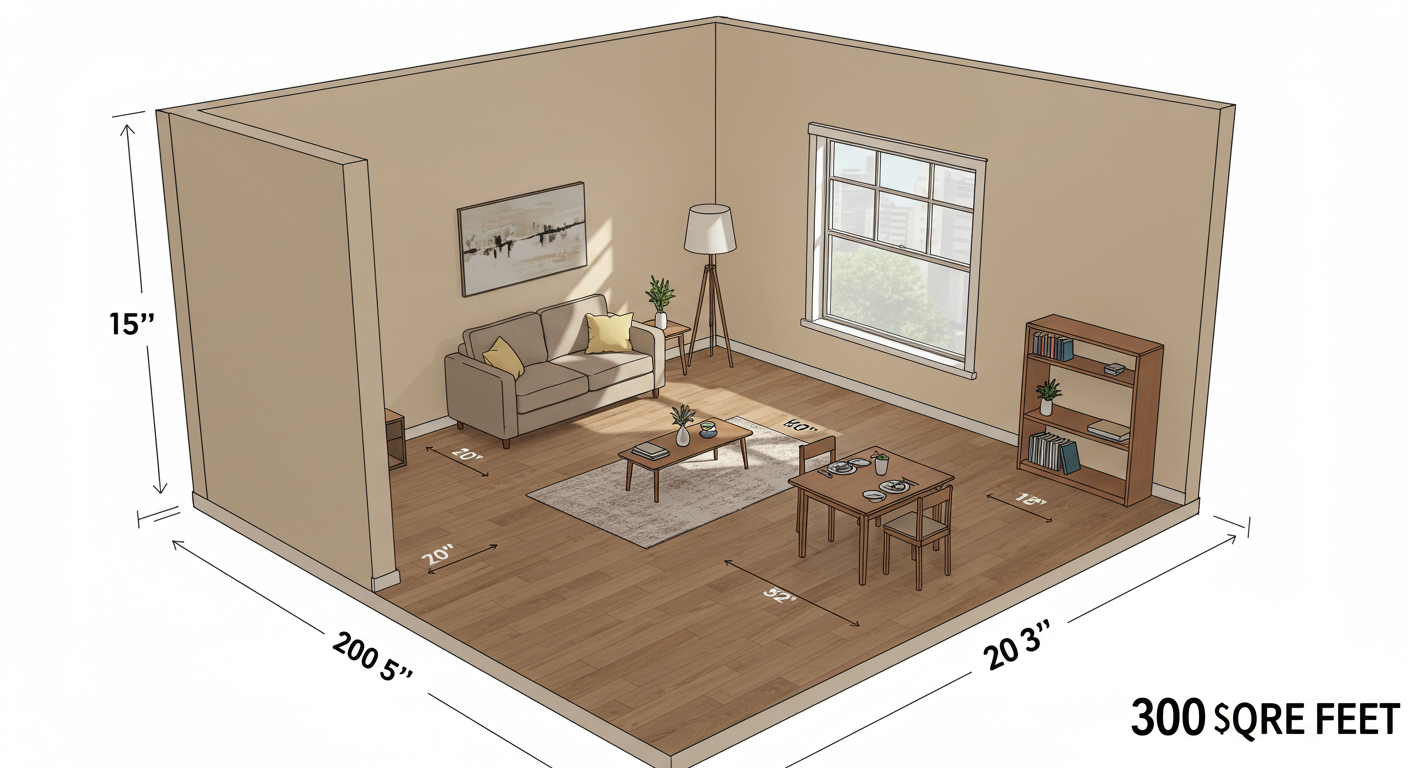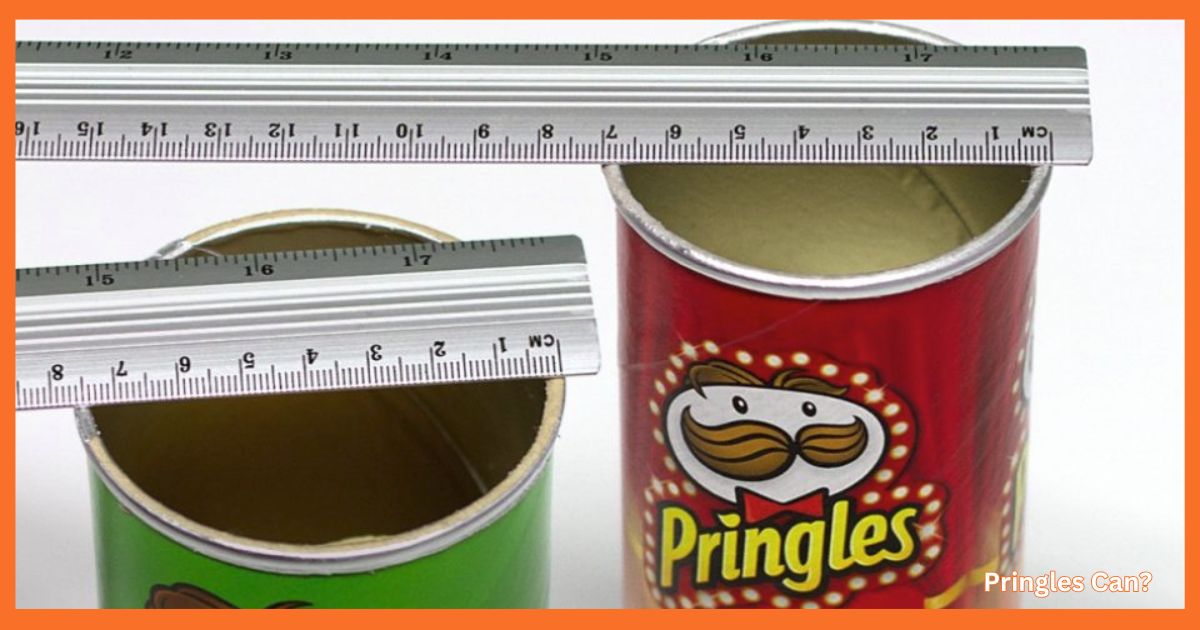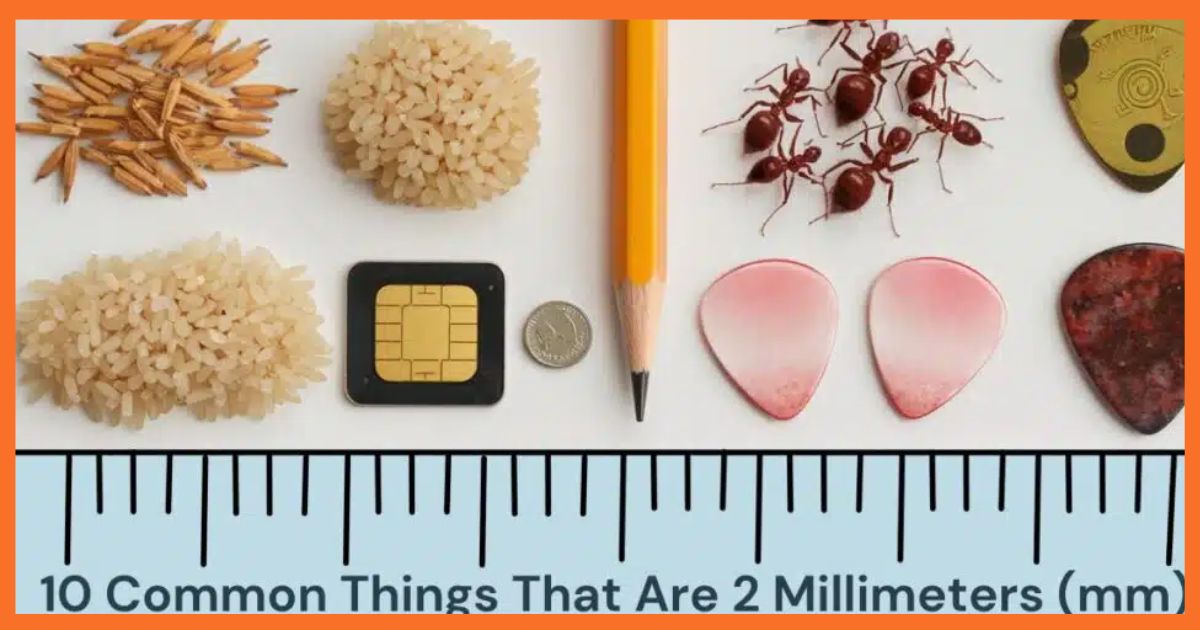So—lemme take you back for a sec. Picture this: I’m house-hunting in a bustling city that swallows rent like it’s popcorn at a midnight movie. And then I see it—a cozy “studio” listed at 300 square feet. Three. Hundred. I blink. Tilt my head. Squint at the screen. Is this a closet with a kitchen? Or am I just being dramatic?
But here’s the kicker… I went to see it. And yeah, it was small, like, laugh-in-the-shower-while-frying-eggs kinda small. But it wasn’t awful. It was… clever. Smart design, warm lighting, and this peaceful charm that I did not see coming. So I started digging deeper. And now, you’re here too. So, let’s get to it.
This isn’t just about numbers. It’s about livability, functionality, and whether 300 square feet can actually feel like home.
First Things First: What Is 300 Square Feet, Really?
If you’re tryin’ to figure out what 300 square feet looks like—stop picturing a mansion, start thinking more along the lines of a hotel room… but cut in half.
Let’s break it down visually:
- A space measuring 15 feet by 20 feet? That’s 300 square feet.
- So is a long, narrow room that’s 10 feet by 30 feet.
- Even a hallway-shaped layout like 6 feet by 50 feet counts (tho, good luck placing a couch in that 😅).
The average U.S. parking space is about 160 square feet, so 300 is just under two parked cars side by side. That’s your living room, kitchen, bedroom, and probably your existential crisis, all packed in together.
Now ask yourself: “Can I actually live here?”
And you know what? Yeah, you probably can. Especially if you play your cards right.
Understanding the Lifestyle: Who’s Livin’ in 300 Square Feet?
Micro-apartment dwellers aren’t always broke college kids or monks. Think:
- Digital nomads who value freedom over furniture
- Minimalists who would rather own 3 shirts than 3 sofas
- Elderly folks downsizing to simplify life
- Artists, students, newlyweds, or the just-plain-adventurous
In places like Tokyo, Hong Kong, and NYC, this kind of micro-living is totally normal. In fact, some of these spaces are engineering marvels—with beds that fold into the wall (Murphy bed vibes), floating desks, and multi-purpose furniture that deserves an Oscar.
It’s not for everyone. But it’s def for someone.
Breaking Down the Space: What’s Actually in There?
You’re not gonna find a grand foyer or a walk-in closet (unless we’re playing Sims), but a functional studio can be surprisingly complete. Here’s what you’ll likely squeeze in:
- A tiny kitchen with a mini fridge, two-burner stovetop, maybe even a compact oven
- A bathroom (small, but usually separate)
- A sleeping area—maybe a couch-bed or a loft bed setup
- Some kind of table or workspace
- Storage? If you’re lucky, built-in shelves. If not, well… get creative.
People think 300 square feet is like living in a sardine can, but the truth is, clever design = cozy comfort.
Studio Apartment Layout: Can It Really Work?
Yes. But it needs to be strategic as heck.
Here are a few layout styles that make living in 300 sq ft feel like less of a gamble:
- Zoned Layouts: Divide your space with rugs, curtains, or open shelving to “zone” it into a sleep/work/cook area.
- Vertical Storage: Think up, not out. Floor-to-ceiling shelves, hanging hooks, and even ceiling-mounted pot racks.
- Floating Furniture and Shelves: They save floor space and look ✨ bougie.
- Mirrors for Spatial Enhancement: It’s not magic, but it feels like it. One large mirror can double the perceived space.
- Multifunctional Furniture: A desk that’s also your dinner table. A bed with drawers underneath. A bench that hides shoes. Go wild.
This is where the interior design for small spaces magic happens. You don’t need to spend a fortune—you just need to plan like you’re playin’ Tetris with your life.
Apartment Sizes Compared: What Else Could You Get?
Alright, let’s zoom out. If 300 square feet feels tight, what do other sizes offer?
- Studio Apartment: Usually 400–600 sq ft. More breathing room, but still open-concept.
- One-bedroom apartment: Typically 600–900 sq ft. You get a separate bedroom. Game-changer.
- Two-bedroom apartment: Think 900–1200+ sq ft. Space for roomies, guests, or your home office dreams.
According to Apartment List, rental costs jump significantly with each upgrade in square footage. So you’ve gotta balance what you need with what you’re willing to pay for. If you’re barely home, a functional studio might be all you need.
Micro-Apartment Living: Not a Fad, But a Lifestyle
Some people treat a micro-apartment like a stopgap. But for others, it’s a permanent move toward a minimalist lifestyle.
And yeah, it ain’t glamorous. There’s no space for impulse shopping, and you’ll definitely learn how often your friends overstay their welcome. But there’s freedom in owning less. Less stuff = less stress.
Also, cleaning takes like… 6 minutes. Not even joking.
Working from Home in a 300 Sq Ft Apartment?

You can. I did. But here’s the catch:
- You need a designated work zone, even if it’s a corner with a floating desk
- Use noise-canceling headphones to mentally “leave” your tiny apartment during work hours
- Avoid the bed at all costs (working from bed = productivity’s funeral)
Throw in a light-colored interior to brighten the space and some compact appliances to make coffee without burning the joint down, and suddenly it doesn’t feel so claustrophobic.
Pro tip: Plants help. Something about them makes it feel like your apartment breathes too.
Tiny Apartment Hacks That Actually Work
Some of these are old-school. Others are straight-up genius:
- Use under-bed storage like your life depends on it
- Try Murphy bed solutions if you can afford the install
- Go all in on multipurpose furniture ideas
- Install wall-mounted lighting instead of floor lamps
- Get a rolling kitchen cart that doubles as counter space
- Hang stuff from the ceiling (plants, lights, even shelves)
- Add a fold-down table for meals or laptop time
Living in a small apartment is like playing chess. Every move should
Read This Blog: https://mozydash.com/is-a-7-inch-penis-big/
How to Personalize Your Small Space
So you’ve made the jump. You’re either livin’ in 300 square feet or considerin’ it. Now what?
Here’s how to make it yours:
- Paint an accent wall—it creates a vibe
- Hang art you actually love, not just generic prints
- Invest in quality lighting (natural and artificial)
- Use zoning tricks like curtains or rugs to define areas
- Add pieces with personality: a funky lamp, a vintage chair, a big ol’ mirror
How to Write a Custom Message (And Deliver It Right)
Okay, let’s switch gears for a sec. Maybe you’re helping a friend or loved one move into a small studio, and you wanna say something thoughtful.
Here’s what to keep in mind:
- Keep it lighthearted but sincere
- Celebrate their courage to try compact living solutions
- Share a tiny home hack with them!
- Write it in a card, on a sticky note, or—better yet—frame it as wall art
Example:
“Here’s to living big in small spaces—where every corner counts and every inch is a story waiting to be told.”
Boom. Instant warmth.
Final Thoughts
300 square feet ain’t for everyone. But for some? It’s more than enough.
It’s not about square footage—it’s about fit. If your lifestyle leans toward simplicity, intention, and a touch of rebellion against the Bigger-Is-Better myth… maybe this space is your sweet spot.
Don’t measure your home in feet. Measure it in laughter, light, and how many times you dance barefoot across the rug just because you can.
So go ahead. Dream big. Even if the dream fits inside 15 feet by 20 feet.
Freqeuntly Asked Questions
“Is 300 square feet livable for one person?”
Yup. But it depends on your habits, stuff, and how attached you are to personal space.
“How to furnish a 300 square foot apartment?”
Start with essentials: bed, table, chair. Then add space-saving furniture like nesting tables, and floating shelves. Avoid bulky stuff.
“What does 300 square feet look like?”
Imagine a medium-sized hotel room. Now shrink it a little. That’s roughly it.
“Can I work from home in a studio apartment?”
Yes, but make it intentional. Use vertical space, divide zones, and keep your bed out of it.
“How to make a small apartment feel bigger?”
Use mirrors, light-colored interiors, vertical storage, and good lighting. And declutter like your lease depends on it.
how big is 300 square feet
300 square feet is about the size of a single-car garage or a large master bedroom. It’s compact but can be functional with smart design.
300 square feet room size
A 300 square feet room could be 15×20 feet, 10×30 feet, or 6×50 feet — the layout greatly affects how spacious it feels.
300 square feet
This size is considered small, suitable for studio apartments or minimalist living, often including a bedroom, small kitchen, and bathroom.
how big is a 300 square foot room
A 300 square foot room offers enough space for basic living needs like a bed, small sofa, kitchenette, and bathroom in a smart layout.
how big is 300 square feet room
A 300 square feet room feels cozy and efficient with proper organization, ideal for solo living in urban areas or student housing.

Rober max seo expert



